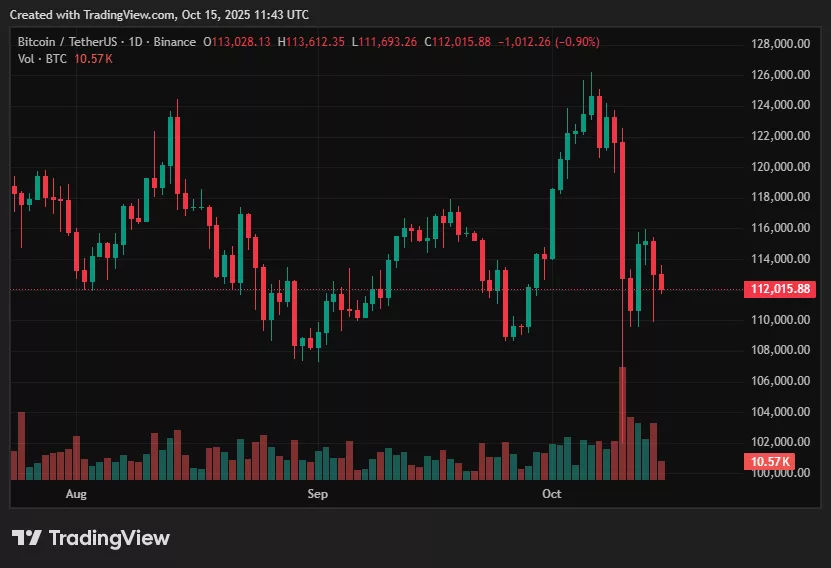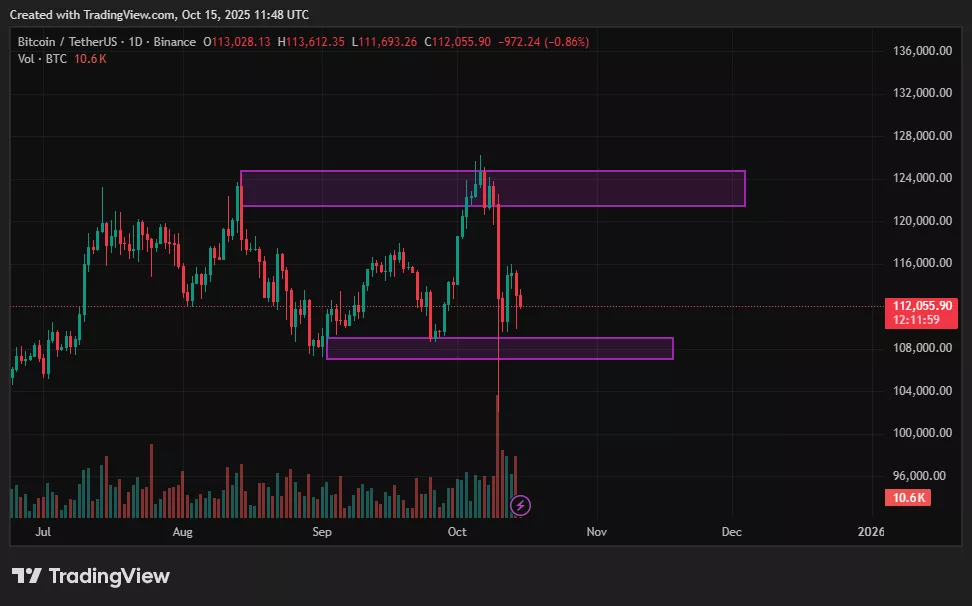
Summary
- BTC price is trading around $112k-$113k ahead of the October 24, 2025, CPI report, as traders brace for extreme volatility.
- Derivatives posture is highly leveraged, with open interest and implied volatility indicating an impending major move.
- ETF inflows totaled over $2.7 billion in early October; however, daily flows remain erratic, indicating institutional hesitancy.
- A modest CPI print could reignite risk-on sentiment and push Bitcoin to $125k-$130k, aided by ETF and momentum buying.
- A high inflation reading risks triggering liquidations of more than $12 billion, potentially bringing BTC below $108K and hitting the $100K level.
- The short-term picture supports range-bound trade ($108k-$118k) until CPI data gives directional guidance.
As the October 24, 2025, release of the U.S. CPI draws near, the cryptocurrency market has entered a phase of nervous anticipation.
The BTC price prediction narrative has become more polarized, with traders debating whether current calmness represents true equilibrium or merely the silence before an explosive move.
The atmosphere now is one of cumulative strain, unlike earlier weeks when momentum and trend seemed to carry themselves. Derivative positioning has grown increasingly extreme, prices have been tightening, and volatility expectations remain suppressed — all of which suggest that a major shift could be imminent.
When inflation data surprises, the question is not whether Bitcoin will move, but rather in which direction it will break. A hawkish surprise could spark aggressive deleveraging across leveraged positions, while a softer CPI print might release a new wave of upward momentum and renewed investor confidence.
Current BTC price scenario

Bitcoin is currently trading between $112,000 and $113,000, having recently dipped below $111,000 before recovering modestly. On the margin, weaker risk appetite and macroeconomic uncertainty have dragged prices down from their late-summer highs. At the same time, ETF and futures data are giving a nuanced signal about what may unfold next in the broader BTC outlook.
ETF flows have been generally favorable in recent weeks, with spot Bitcoin ETFs recording $2.71 billion in net inflows in the week ending Oct. 10. However, intra-week flows have been variable, with considerable outflows (e.g., ~$756 million in U.S. spot Bitcoin ETF outflows) on some days.
This shows that institutional demand is present but susceptible to short-term risk triggers. On the derivatives front, open interest in Bitcoin futures has skyrocketed – Citigroup reported a 3.2% increase in total open interest as the broader derivatives market shifted.
Liquidation wipeout shows shaky structure
Meanwhile, large-scale liquidations have already occurred, with over $11 billion of leveraged positions wiped out in one of the greatest single-day futures reductions in recent memory.
This emphasizes how sensitive the structure is; with leverage stacked high, additional shock events could cause cascades.
Despite this, market makers and options desks are keeping implied volatilities above recent realized vol. In effect, players are paying a premium for optionality, implying that the forthcoming CPI may cause significant price volatility.
Bull case for BTC price
If the CPI reading comes in lower than expected, indicating additional disinflation or lowering core pressures, it might act as a powerful stimulus for fresh risk appetite. Equities, credit, and cryptocurrency are likely to surge in unison. In such a scenario, Bitcoin (BTC) would be well-positioned to move significantly northward.
The mechanics are simple: lower inflation reduces the market’s discount on future Fed tightening, boosts sentiment toward risk assets, and removes a psychological barrier for institutional buyers to reinvest. When combined with existing leverage and open interest, this momentum might snowball as stop losses above crucial levels are triggered.
On the technical front, regaining and maintaining a price above $118,000 to $120,000 would revive the bull case. A breakout above $122,000-$124,000 is likely to draw new momentum buyers and aggressive ETF inflows. At that time, altcoins and secondary markets may amplify the rise, making a run to $125,000-$130,000 feasible, particularly if the larger macro backdrop (e.g., US yields, equities expansion) cooperates.
In such a scenario, what begins as a relief rally could evolve into a broader Bitcoin forecast for renewed institutional accumulation. The narrative would shift decisively from defensive positioning to opportunistic risk-taking, underpinned by growing belief that inflation has been contained and liquidity conditions are set to improve.
Downside outlook for Bitcoin price
However, the other side is quite real: if headline and core CPI readings surprise to the upside (i.e., inflation remains stable or accelerates), markets will most likely rethink rate expectations substantially. Such a print would exacerbate risk aversion in markets, drive bond yields higher, and bleed repricing pressure into cryptocurrency.
In this case, Bitcoin’s leverage structure becomes a key vulnerability. As prices fall, forced liquidations of long futures or perpetual holdings may cascade. Analysts predict that a 5% price decline from mid-$110k might result in ~$12.5 billion in cascading liquidations across key exchanges (e.g., Binance, Bybit). Once the stops cascade, the path of least resistance becomes steeper downward.
Further losses are possible
If BTC fails to retain support in the $108,000 to $110,000 range, it may lead to further losses, potentially reaching $100,000±. That level is psychologically significant and might act as the first major structural floor in a risk-off unwind. In such a decline, ETF flows may flip (outflows), and liquidity may rapidly degrade into slippage and gap behavior on low volume.
It’s easy to foresee a whipsaw: a brief rally, increased selling, and further decline as derivative desks and algorithmic techniques reprice.
BTC price prediction based on current levels

BTC is expected to remain rangebound for the next few days, ranging between $108,000 and $118,000, as market participants await the CPI catalyst. That phase will most likely be marked by low volume, intermittent fakeouts, and high noise-to-signal days.
If price manages a convincing break over $122,000-$124,000, the regime will shift in favor of further higher. Short covering, momentum chasing, and ETF inflows could propel the rally to $125,000-$130,000, especially if macro momentum coincides (lower rates, good stocks).
A break and closure below $108,000, on the other hand, would dramatically change the narrative toward downside risk, perhaps accelerating a slide to $100,000 or lower as deleveraging and capitulation set in.
In the broader expectation and projection, the upcoming CPI release is less a long-term turning point than a short-term trigger.
While the breakout direction will determine initial momentum, the depth and sustainability of any move will depend on follow-through, namely, whether institutional capital and sentiment shifts persist beyond the event window. In a soft-CPI scenario, the rally could carry into late October; in a hot-CPI scenario, weakness may persist as markets recalibrate to a higher-rate reality.
Disclosure: This article does not represent investment advice. The content and materials featured on this page are for educational purposes only.

Source link

